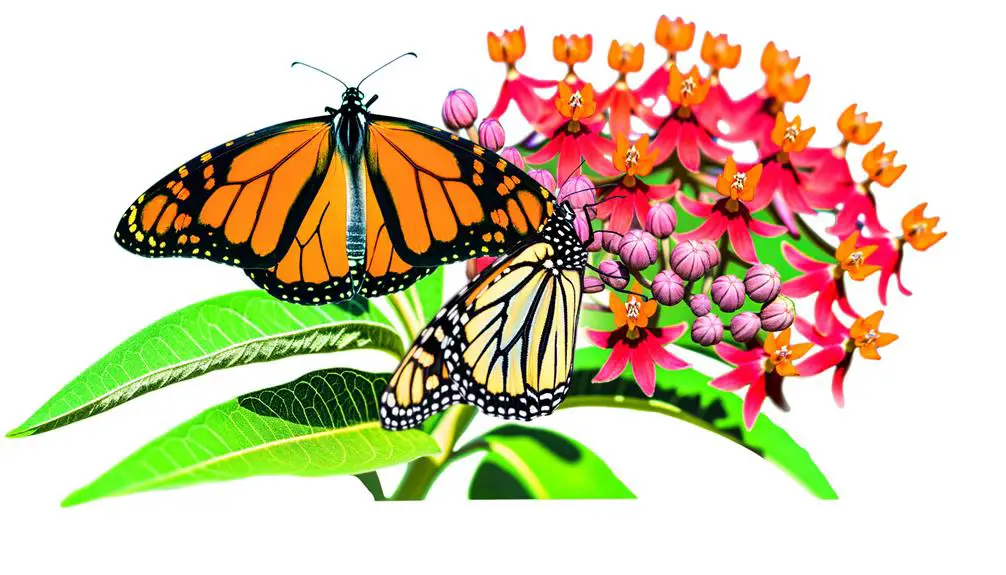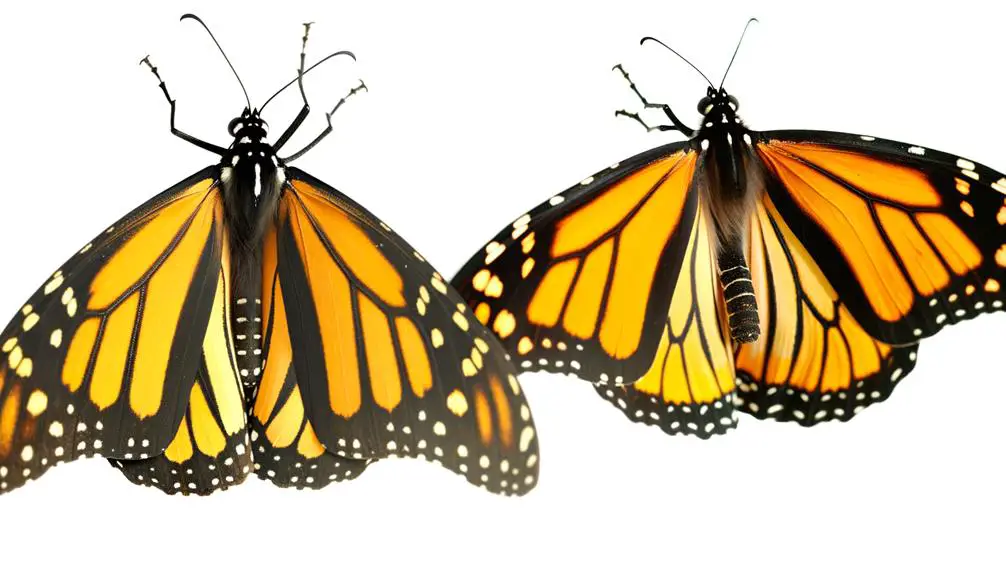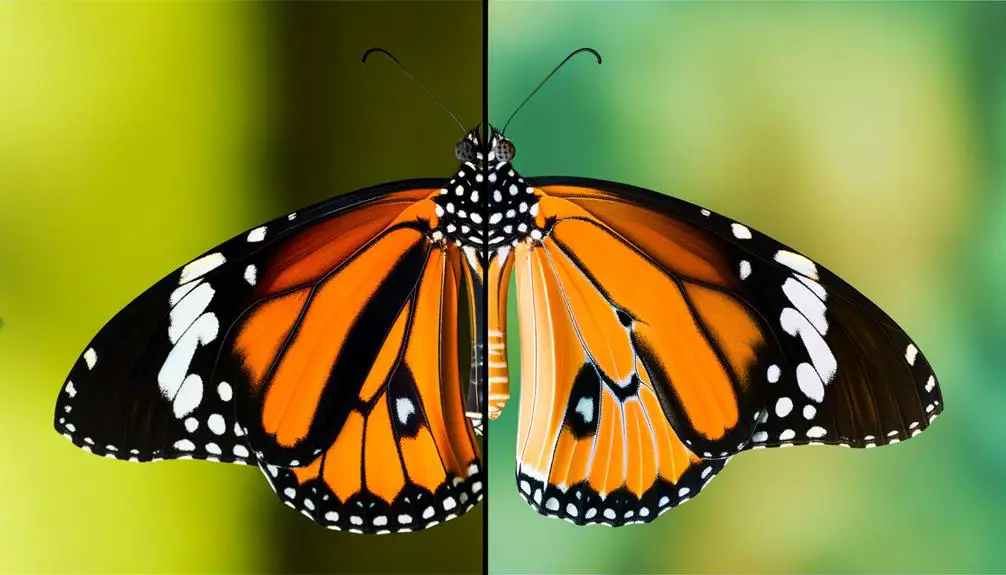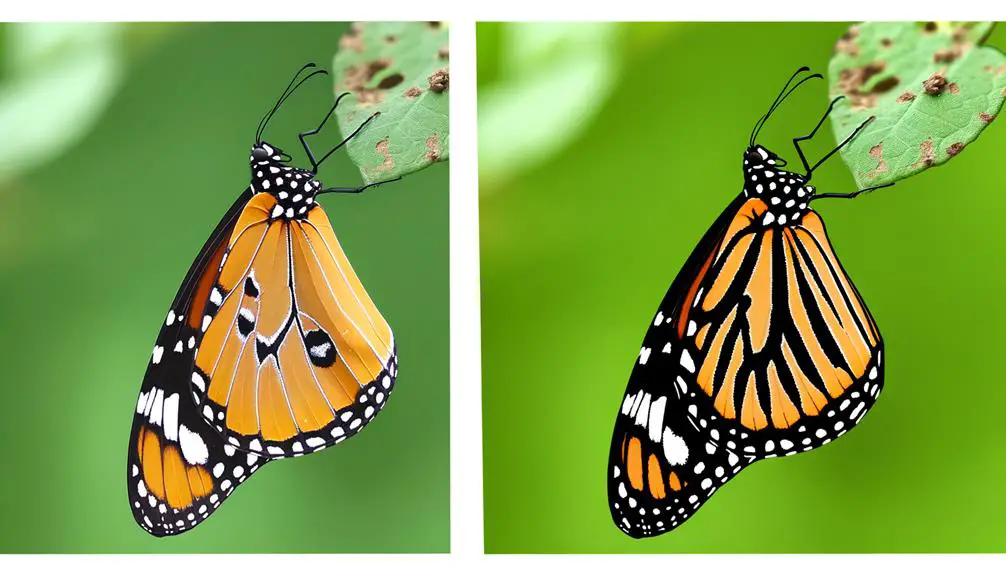How to Identify Male vs Female Monarch Butterflies
Monarch butterflies exhibit notable sexual dimorphism. Males possess black androconial patches on their hind wings, which females lack.
Male veins are thinner with a brighter orange hue, while females have thicker veins and darker coloration. Females are generally larger with broader wings and a robust abdomen to support egg-laying.
Males have slender abdomens and smoother wings. Pheromone spots on males aid in attracting females, which are absent in females.
Behavioral distinctions include males demonstrating territorial and pursuit flights, while females focus on oviposition site selection. Further investigation into these differences reveals their ecological and evolutionary significance.

Key Takeaways
- Males have black androconial patches on hind wings, absent in females.
- Female monarchs are larger with thicker black wing veins and a broader abdomen.
- Males display brighter orange wings with smoother texture compared to females' darker, textured wings.
- Males have scent glands and release pheromones for mating, which females lack.
Wing Coloration Differences

Male and female monarch butterflies exhibit distinct differences in wing coloration, which can be used as reliable markers for sex identification.
Males possess two black spots, known as androconial patches, located on the hind wings, which are absent in females. These specialized scales release pheromones during mating rituals.
Additionally, male monarchs generally have thinner black veins on their wings compared to females, who display thicker and more pronounced veining.
The orange hue in males tends to be slightly brighter and more vibrant, whereas females often exhibit a more subdued, darker orange.
These differences in wing coloration not only facilitate accurate sex determination but also play a significant role in their reproductive behaviors and ecological interactions.
Black Vein Patterns
The black vein patterns on monarch butterfly wings serve as essential indicators for distinguishing between sexes, with females exhibiting thicker and more pronounced veins compared to their male counterparts. These distinctive markings assist in the straightforward identification of gender, underscoring the intricate beauty of Lepidoptera morphology.
| Observation | Male | Female |
|---|---|---|
| Vein Thickness | Thinner | Thicker |
| Vein Definition | Less Pronounced | More Pronounced |
| Wing Texture | Smoother | Textured due to pronounced veins |
| Visual Contrast | Lower | Higher |
Precise observation underpins this analytical approach, providing a deeper understanding of monarch butterflies' sexual dimorphism. Such insights not only enrich our biological knowledge but also inspire awe in the natural world, empowering us to appreciate the liberty inherent in nature's designs.
Size and Shape Variations

Notable size and shape variations between male and female monarch butterflies contribute considerably to their sexual dimorphism. Females generally exhibit larger and more robust body structures.
Females possess broader wings and a more rounded abdomen, which are likely adaptations for egg-laying and greater energy storage. Conversely, males tend to have narrower wings and slimmer abdomens, facilitating more efficient flight for mate searching.
These morphological distinctions are critical for their respective reproductive roles, influencing flight dynamics and energy expenditure. Quantitative measurements have consistently shown that females have a higher wing loading, which correlates with their increased size.
The structural differences underscore the evolutionary pressures shaping male and female monarch butterflies, ensuring optimized survival and reproductive success within their ecological niches.
Presence of Pheromone Spots
Distinctive pheromone spots, located on the hind wings, serve as key identifiers for male monarch butterflies, playing an essential role in mating behaviors.
These specialized scales, often appearing as small black dots, release chemical signals that attract females, facilitating reproductive success. Females lack these pheromone spots, a sexual dimorphism that provides a straightforward method for gender differentiation.
Rigorous observation reveals that the pheromone spots are situated within a vein structure unique to males, enhancing visibility during courtship displays. This morphological trait underscores the evolutionary adaptations monarchs have developed to optimize mating efficiency.
Consequently, the presence or absence of these pheromone spots is a critical diagnostic characteristic for entomologists and lepidopterists studying Danaus plexippus.
Abdomen Characteristics

Abdomen characteristics in monarch butterflies exhibit sexual dimorphism, providing additional methods for distinguishing males from females.
Males typically possess a narrower abdomen with a more tapered tip, while females exhibit a broader and more rounded abdomen. This distinction is due to the females' need for a larger space to accommodate egg production.
Key differences include:
- Shape: Males have a slimmer, more streamlined abdomen.
- Size: Females present a visibly wider abdomen, important for reproductive purposes.
These morphological differences are vital for researchers and enthusiasts aiming to accurately identify and study the sexual dimorphism within monarch butterfly populations, ensuring effective monitoring and conservation efforts.
Behavior and Activity
In analyzing the behavior and activity of monarch butterflies, notable distinctions are observed in migration patterns, mating rituals, and feeding habits between males and females.
Males typically exhibit more territorial behavior during mating, often engaging in pursuit flights.
Conversely, females are more focused on oviposition site selection, influencing their migratory and feeding behaviors.
Migration Patterns Differences
Analyzing the migration patterns of monarch butterflies reveals notable behavioral and activity differences between males and females.
Males typically exhibit broader dispersal ranges, potentially due to their role in seeking out females across vast areas. Females, conversely, show a more direct migratory route, possibly linked to their focus on oviposition sites.
Observational studies highlight:
- Energy Expenditure: Males engage in longer flights, which may impact their energy reserves differently than females.
- Resting Periods: Females tend to take more frequent resting breaks during migration, likely to conserve energy for egg-laying.
Such differences underscore the intricate balance of survival strategies within monarch butterfly populations.
Mating Rituals Variations
The distinct migratory behaviors of monarch butterflies are mirrored in their mating rituals, where males and females exhibit unique behavioral patterns and activities.
Males engage in patrolling, employing aerial chases to locate receptive females. They utilize specialized pheromones released from scent scales, or androconia, to attract mates.
Females, in contrast, exhibit selective behavior, evaluating male vigor and pheromone quality before acquiescing to copulation. This selectivity guarantees genetic robustness.
Mating typically occurs in late morning and early afternoon, optimizing thermal conditions for flight.
Post-mating, males exhibit mate-guarding behavior, ensuring reproductive success.
These ritualistic variations underscore the evolutionary strategies that promote species propagation, reflecting the intricacies of sexual selection and reproductive fitness in Danaus plexippus.
Feeding Habits Comparison
Comparative analysis of feeding habits between male and female monarch butterflies reveals distinct behavioral patterns and preferences that align with their physiological needs and ecological roles.
Females often exhibit higher nectar consumption rates to support egg production and oviposition activities. Males, however, prioritize nutrient intake to sustain energy levels required for prolonged mating pursuits and territorial defense.
Key observable distinctions include:
- Nectar Sources: Females prefer a wider variety of nectar-rich flowers, enhancing their reproductive success.
- Feeding Frequency: Males exhibit more frequent but shorter feeding bouts, optimizing time for mate-seeking behavior.
These differences underscore the evolutionary adaptations in monarch butterfly feeding strategies.
Role in Reproduction

In the context of reproduction, male and female monarch butterflies exhibit distinct roles characterized by specific behaviors and physiological processes.
Males engage in unique mating flight patterns and release pheromones to attract females, while females are primarily responsible for the egg-laying process.
These differences underscore the specialization of each sex in ensuring the continuation of the species.
Mating Flight Patterns
Distinctive flight patterns exhibited by monarch butterfly males are integral to their successful mating strategies. These aerial maneuvers are characterized by precision and agility, designed to attract and secure a mate.
Observations indicate that males engage in:
- Pursuit Flights: Males chase females in rapid, zigzagging patterns to demonstrate fitness and stamina.
- Hovering Displays: Males hover near potential mates to showcase their vibrant wing patterns and physical prowess.
Such behaviors underscore the critical role of flight in reproductive success. The males' ability to perform these intricate patterns directly influences their mating opportunities and, consequently, the propagation of their genetic material.
These observations offer insights into the adaptive strategies of monarch butterflies.
Pheromone Release Differences
Pheromone release plays a pivotal role in the reproductive strategies of monarch butterflies, with males and females exhibiting distinct differences in their chemical signaling processes.
Male monarchs possess specialized scent glands located on their hindwings, known as androconia, which emit pheromones to attract females and facilitate mating. These pheromones are critical in establishing male reproductive fitness by signaling genetic quality to potential mates.
Conversely, female monarchs do not release pheromones for attraction but are receptive to male pheromones, thereby ensuring successful copulation.
This dichotomy in pheromone release underscores the evolutionary adaptations that maximize reproductive success. Understanding these mechanisms provides insight into the complex interplay of chemical communication and reproductive behavior in Danaus plexippus.
Egg Laying Process
While male pheromones play a significant role in attracting mates, the reproductive success of female monarch butterflies is heavily influenced by their meticulous egg-laying process.
The females exhibit a keen ability to identify ideal milkweed plants, ensuring larval survival and development. This selection process is critical, involving:
- Host Plant Selection: Females utilize chemical and visual cues to locate milkweed, the sole food source for their larvae.
- Egg Placement: Strategic placement of eggs on the underside of leaves minimizes predation risk and environmental hazards.
These behaviors illustrate the female's pivotal role in the monarch's life cycle, underscoring their contribution to species propagation.
Conclusion
In the grand symphony of Danaus plexippus, the minutiae of wing coloration, vein patterns, and pheromone spots serve as the maestro's baton, orchestrating the roles of male and female monarch butterflies.
Size, shape, and abdomen characteristics further delineate these actors on nature's stage.
Ironically, while human endeavors often shun gender distinctions, here, they are paramount for survival and reproduction.
Consequently, in the theatre of entomology, sexual dimorphism is not merely a subplot but the crux of the narrative.






